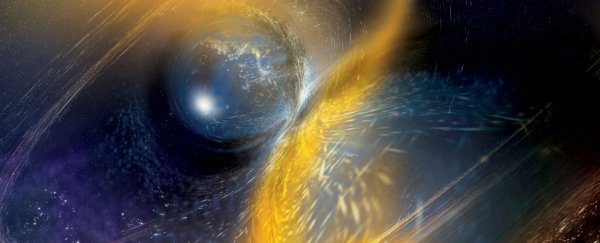Our magnificent gravitational wave astronomers have done it again, adding to the detection collection a new collision between two neutron stars. On 25 April 2019, the LIGO interferometer detected two neutron stars around 520 million light-years away coming together and merging into a single object.
It's called GW190425, and although it's only the second such collision astronomers have ever seen, it's already broadening our understanding of these colossal cosmic smash-ups.
"The source of GW190425 represents a previously undetected type of astrophysical system," the researchers wrote in their paper, submitted to The Astrophysical Journal Letters and not yet peer-reviewed.
The first binary neutron star collision event was detected in August 2017, and it provided a glorious abundance of data across a range of observation media - what is known as multi-messenger astronomy.
Now this new detection has confirmed it.
"We have detected a second event consistent with a binary neutron star system and this is an important confirmation of the August 2017 event that marked an exciting new beginning for multi-messenger astronomy two years ago," said physicist and Virgo Spokesperson Jo van den Brand of Maastricht University in the Netherlands.
There are some very important differences.
Unlike the first neutron star event (called GW170817), there was no light detected when the two stars of GW190425 collided. That's probably partially because it was so far away, and partially because one of the two LIGO detectors was offline when the event was detected; and the signal was too faint to be detected by the Virgo detector.
This meant tracing the origin point of the signal was very difficult; but the non-detection by Virgo allowed the international team of astronomers to narrow down the region from which the signal must have originated - a swathe covering about 20 percent of the sky.
And even without optical data, the "chirp" of the gravitational wave signal can be decoded to discover the mass, orientation and spin of the colliding objects.
And this contained a hefty surprise. Based on the chirp data, the team discovered that one of the neutron stars in the binary was 1.4 times the mass of the Sun, and the other was around 2 times the mass of the Sun.
"We were very surprised by the total mass of this ancient neutron star binary system, which is about 3.4 times the mass of our Sun, as it far exceeds the mass of known neutron star binaries in our own galaxy," said theoretical physicist Susan Scott of the Australian National University and ARC Centre of Excellence for Gravitational Wave Discovery.
"This leads to the intriguing possibilities that the old binary system we've discovered formed differently to those observed in the Milky Way and that neutron star binaries this massive may not be detectable by current telescope surveys."
The two neutron stars involved in GW170817 were between around 1.1 and 1.6 solar masses, resulting in an object around 2.7 times the mass of the Sun.
And, although we haven't detected many neutron star mergers, astronomers have identified 17 existing neutron star binaries within the Milky Way against which to compare the mass. Of those, the highest combined mass is 2.9 times the mass of the Sun.
This could help astronomers understand how binary neutron stars form. There are two possibilities - that the two massive stars are born, live and die together; or that they capture each other in orbit later in life. It's unclear which of these produced the GW190425 binary, but modelling could reveal more information.
The object resulting from the GW190425 collision also presents an intriguing prospect, because it's smack-bang in something called the mass gap that sits between neutron stars and black holes.
Both neutron stars and black holes are the ultradense remains of a dead star, but we've never seen a black hole smaller than 5 times the mass of the Sun, or a neutron star larger than around 2.5 times the mass of the Sun.
We don't know yet if GW190425 resulted in a small black hole or a big neutron star, but it - and the object produced by GW170817, which is also still unknown - could reveal some answers about this weird mass gap.
The team presented their findings at the 235th Meeting of the American Astronomical Society in Hawaii.
